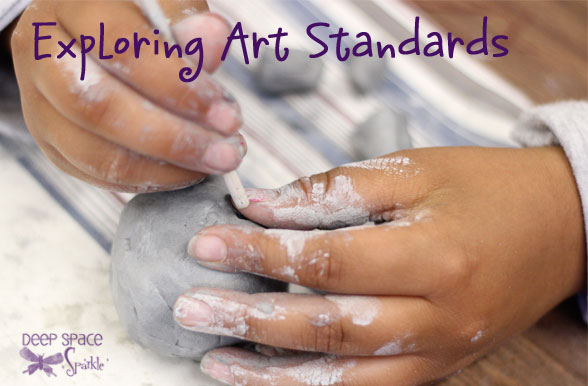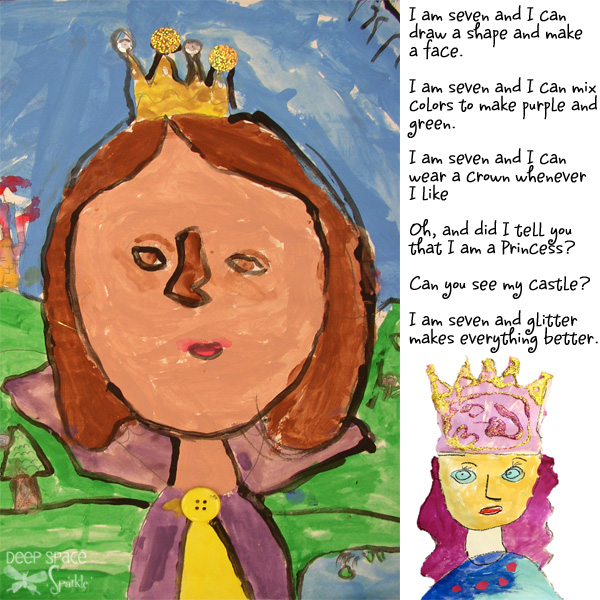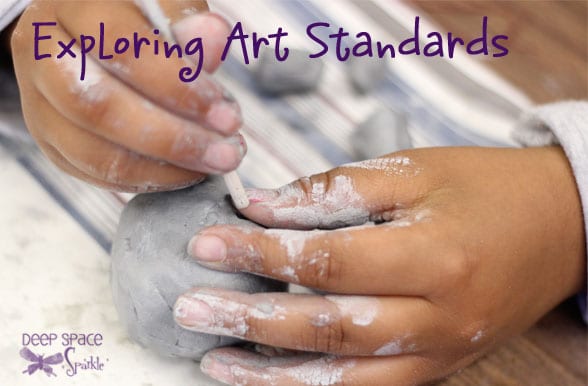
Earlier in the summer, I had the privilege of teaching an art instruction e-course to art teachers, home-school parents and classroom teachers from around the world. One of the best part of the e-course for me was the forum. Teachers expressed their concerns over tight schedules, asked for help with organization and contributed tips for better classroom management.
One of the underlying concerns was addressing the art standards. I’ve always shied away from standards because I am not required to teach them. I am a consultant hired by my school district to deliver an art program but the classroom teachers are the ones to impose the art standards.
Still, I consider it my job to ensure that children learn all the fundamentals of art but I don’t use standards to develop my curriculum. DSS readers have asked me why I don’t include standards in my art lessons. I have to be honest with you. While the standards do include valuable guidelines, they are verbose and don’t hold my attention. That’s the truth.
Let’s take a look at California’s first grade Visual Arts standards:
1.0 ARTISTIC PERCEPTION. Processing, Analyzing, and Responding to Sensory Information Through the Language and Skills Unique to the Visual Arts. Students perceive and respond to works of art, objects in nature, events, and the environment. They also use vocabulary of the visual arts to express their observations.
2.0 CREATIVE EXPRESSION. Creating, Performing, and Participating in the Visual Arts. Students apply artistic processes and skills, using a variety of media to communicate meaning and intent in original works of art.
3.0 HISTORICAL AND CULTURAL CONTEXT. Understanding the Historical Contributions and Cultural Dimensions of the Visual Arts. Students analyze the role and development of the visual arts in past and present cultures throughout the world, noting human diversity as it relates to the visual arts and artists.
4.0 AESTHETIC VALUING. Responding to, Analyzing, and Making Judgments About Works in the Visual Arts. Students analyze, assess, and derive meaning from works of art, including their own, according to the elements of art, the principles of design, and aesthetic qualities.
5.0 CONNECTIONS, RELATIONSHIPS, APPLICATIONS. Connecting and Applying What Is Learned in the Visual Arts to Other Art Forms and Subject Areas and to Careers.
I don’t know about you, but I think these standards sound like a college syllabus for Introduction to Art 101. I realize that the verbiage is meant for the teacher, but no one can defend the tone of the standards. It feels overly sophisticated and simplified at the same time. I think if I were a new art teacher coming out of a credential art program and was asked to develop a curriculum based on standards, I would run away. Fast.
What I really think the standards are meant to say, is that we as art teachers, should provide art lessons rich in art elements, painting and drawing techniques, cultural, literature and historical connections, as well as engage their imaginations. Don’t you think that should be at the top of the list?

My standards
I’m tempted to provide some colorful commentary on each of the above standards, especially how they apply to seven year olds, but I think it best to keep honoring my instincts when it comes to teaching art to children. Here are a few of my art standards:
- Should respond to their artwork with laughter and enthusiasm
- Expected to squirm, giggle, get messy, paint on their hands and arms, doodle on every piece of paper they see and not stop painting when asked.
- Will ooh and ahhh when they discover that by mixing blue and yellow paint, green paint will appear
- Will learn how to draw by listening and observing
- Expected to mix every single paint on the colorwheel together so they can discover the color of mud
- Expected to stand up while painting or drawing or molding
- Shall talk endlessly about their artwork to the point that they drive you crazy
Okay, now it’s your turn. What would your standards include?
FIND ART LESSONS THAT WILL ENGAGE YOUR CLASS WITH FUN AND LEARNING. CLICK BELOW TO LEARN MORE ABOUT THE MEMBERS CLUB…














Yes! Thank you so much for writing about this, Patty. I LOVE your standards for first grade. In the end, all children should be excited, feel good about and love art. I’m going to adopt your standards next year.
Julie
Honestly!!! Standards are sooo well standard. I love your standards, it engenders creativity and such. I am not a teacher per se I help my daughter teach her children at home, and I want them to love art so I love your site because it does just that. Thanks!
I also teach elementary art in California and I’m glad to know I’m not the only one who finds them “overly sophisticated and simplified at the same time”. Thanks for putting into words my thoughts. I have a position similar to yours so I am not tied to them. I try and pull out what I think are the key concepts from each grade level. Hopefully in the end my standards align closely with what you’ve written because to me that is what it is all about. One addition might be, First Graders will proudly show off their artwork to anyone walking by at the annual art show.
I know what you mean about the standards, Patty! They do seem like an unnecessary formality in a lot of ways, and I know many art teachers aren’t required to pay any attention to them! But I thought I would chime in as a teacher who IS required to teach with our state standards in mind. My school is working on becoming accredited through both WASC and ACSI, so I have to carefully document what I’m teaching through curriculum mapping, which includes identifying the state standards for each lesson I teach. It’s a lot of extra work, but once I just accepted that I have to do it, I realized it’s not really so bad. I still have lots of freedom in what I can teach, as most lessons can be “tweaked” to include standards that need to be addressed. I’ve even found that in trying to cover all the standards, I’ve been forced to stretch myself to be more creative in ways I wouldn’t have otherwise had to be! I love your fun approach to teaching art, and I think we can still maintain that sense of fun while addressing the standards, if that’s what’s required. Maybe they just need to be rewritten to sound a little less boring and a little more fun!
I understand and can relate to all the other art educators out there in blog land that are looking for help with deciphering and implementing their states standards. My personal art standards do include all the creative,imaginative experiences you mentioned but, I am also held accountable for making sure that I have covered all the standards for visual arts set forth by my state and school district. I spent many days with fellow art educators last school year re-writing our visual arts curriculum. Yes, the standards set forth by the state are difficult to digest and wordy( and give me a massive headache at times) but I break them down into child friendly terms for my essential questions for each lesson. At the same time I do make sure that my students enjoy their art experiences. This year our state is implementing new teacher evaluation systems and being a non-state tested subject area we must show concrete assessment models based on the standards the state has set before us. For most of us standards are a necessary and mandatory part of our art programs. Patty , you always come up with awesome projects and all of them are in one way or another in line with the standards the state has set forth as well as your personal standards. Without standards I think that our programs would be thought of as fun fluff and not an important part of a child’s whole education. 🙂
Patty,
I have found your blog through pinterest and I’m so happy I did!!!
I have never formally taught art, but have always done something with my child’s special ed class. I’ve been asked to do a project once a month now that she is at the high school level, which means more of a grade school level in regards to skill levels. That’s why your blog blew me away with so many wonderful ideas that areeasily adaptable. Thank you for sharing so much!
Lynn
Yes Mam! I did what I was told like the good girl I am. I pinned it under ‘Good Advice’
Like you I am a consultant art teacher in schools here in Ireland and so I do not have to involve myself in grading children’s artwork. Thank goodness! I love to see what I call a ‘breakthrough’ – when a child take s a new step in understanding what he or she is doing. When they can see for themselves that it looks ‘better’!
Love your art standards! As an elementary school teacher, I find that all the state standards sound like the ones you listed. Somewhere along the line, those with no education experience at all have forgotten that when kids love to learn, they learn. They have taken all the fun out of elementary school!
Hi Patty,
In Toronto we have curriculum standards for all of the arts (visual, music, drama, dance) and for us we are lucky to have them. We have fought hard in the past to have all of the arts included in our curriculum so they are valued, accessible to every student, training is available and they are funded by the Ministry of Education. Our computer or technology does not have a curriculum from the Ministry and such we are not funded, in other words, we’re on our own in purchasing and teacher training! What we find making the standards easier to work with is to “translate” them in to parent/student language. Mine for Kindergarten sound very much like yours! Thanks!
I agree and was thrilled to read that The National Art Education standards are being updated to reflect this…I was happy to read a similar sentence in on of the White Papers written and published on the NAEA website homepage and emailed recently to members. ”
“Excellent Visual Arts Teaching is Balanced
In contrast to stereotypical “make and take” school art
projects, art is a vital and core subject that should be seen
as balanced, interdisciplinary, and grounded in meaning and
inspiration. Furthermore, traditional overemphasis on formal
qualities (in terms of studio materials, as well as art elements
or design principles) is insufficient in a digital global world
where social and other forms of communicative media are
prevalent in daily life.”
http://www.arteducators.org/advocacy/NAEA_WhitePapers_3.pdf
I wish we could do art for art and music for music, etc. without having to validate what we do with standards and benchmarks. If a child loves art then maybe they will grow up wanting to do the visual communication career ” for a global world” but why force all these benchmarks on them when they are in elementary school? Why can’t they just paint to learn how to paint and make a pinchpot to experience clay? Why does it all have to have a deeper, grown up connection to something else?!
Now something even worse is happening in my state. Our schools are so afraid of not passing the state standardized test that EVERY teacher in EVERY subject area now has to “help” pass the test. So, I am doing an art project right now to help them pass the MATH section of the test and there is more and more pressure to do “art” that really is designed to help pass a subject area on the test. I consider this a sad turn of events when my artroom becomes another way to teach to a test of other subjects! Very very upsetting.
I hear you…that is really just sad.
Oh thank you for the laugh. I’ve been in a standards reading, applying and trying to retrofit in to lesson plan documents all weekend. I needed that!
Which would be your standards for Kindergarten?
I’m reading through all of your questions and I’m starting seeing a “theme” to your observations! My standards for Kindergarten would be about the same, as these first grade standards are not real standards but an example of how I approach art.
I love love love your standards! Thank you for sharing all of your wonderfully helpful and inspiring ideas!
I love your take on teaching art and the take on standards. You keep it fun and light-hearted, but I have to say that using the resources the books and the lessons my kiddos are getting a very rich experience in art. Thank you so much for being there!
Thanks for sharing your thoughts and work!! It’s going to help a lot!